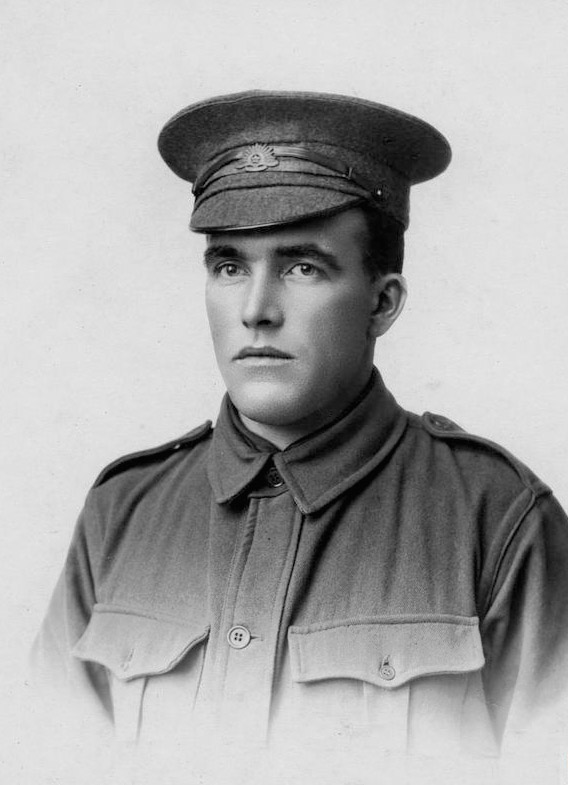

Selwyn Kemp SKIPWORTH
Born 21 September 1891 in Dromana, Victoria, Australia [350: 8-Sep-1917]
Son of Frederick James SKIPWORTH and Sarah Parsons LAMING [54] [55]
His parents were both from South Australia, having married at Saint Paul's Church in Adelaide on 22 March 1882 [55]
He grew up in Kadina, Cowell and McLaren Vale in South Australia before moving to Western Australia in 1914 [350: 8-Sep-1917]
His father had died in 1902 aged 46 and in 1912 his mother married again in Western Australia to Job SELWOOD [55] [66]
He departed from Adelaide, South Australia on the steamship Otway and arrived in Fremantle, Western Australia on 6 October 1914 [23]
At one point, while working as a Labourer, he lived with his mother and stepfather at 219 Attfield Street in South Fremantle [50]
Contractor employed by Samuel J. M. GREEN in Carnamah, Western Australia in 1915 [34]
He was working fulfilling the farming contracts GREEN Bros had with the Midland Railway Company in Carnamah [34]
In April 1915 he wrote to the Midland Railway Company wanting to buy Lot M949 in Carnamah, one of their Ready-Made Farms [34]
The Midland Railway Company replied to his letter stating they would only sell Lot M949 together with Lot M946 [34]
He didn't go ahead with buying land in Carnamah [34] but later took up land at Pithara, near Wongan Hills [350: 8-Sep-1917]
Farmer in Pithara, Western Australia in 1916 [30: item 8085788] [225: 29-Mar-1916]
He was passed as fit for active service in the Australian Imperial Force (A.I.F.) in Perth on 29 March 1916 [225: 29-Mar-1916]
Upon enlisting in the A.I.F. he was 5 feet 6 inches tall, weighed 137 pounds and had brown eyes and hair and a dark complexion [30]
After initial training he was appointed to the 2nd Reinforcements of the 44th Australian Infantry Battalion on 4 August 1916 [30]
He embarked from Fremantle, Western Australia for active service abroad on the H.M.A.T. A28 Miltiades on 7 August 1916 [30]
Disembarked in Plymouth, England and after further training was transferred to the 34th Australian Infantry Battalion [30]
He embarked from Southampton, England and proceeded to France on 21 November 1916 [30]
Private 1904A in the Australian Imperial Force's 34th Australian Infantry Battalion in France during the First World War [30: item 8085788]
He was wounded in action in France on 23 July 1917, suffering gunshot wounds to his back, arm and foot [30]
Received treatment from the 11th Field Ambulance and was taken to the 2nd Australian Casualty Clearing Station, where he died [30]
Died 24 July 1917 in France; buried Trois Arbres Military Cemetery in Steenwerck, Nord, France [17]
Over the following six years his mother received three photos of his grave, his Memorial Scroll, Memorial Plaque and Victory Medal [30]
His mother also received his personal effects that were with him in France, which included letters, photos, cards, [30]
mirror, gold ring, chain, comb, pencil, wrist watch, diary, wallet, religious medallion and a YMCA membership card [30]
His death notice in The West Australian read "He to duty's call responded; And for mother, home and country nobly fell" [39: 10-Aug-1917]
The Daily News newspaper in South Australia described him as "quiet and reserved" [445: 4-Sep-1917]
The Chronicle noted "he laid down his life that succeeding generations might be free from the hand of the oppressor" [350: 8-Sep-1917]
| Reference: Carnamah Historical Society & Museum and North Midlands Project, 'Selwyn Kemp Skipworth' in Biographical Dictionary of Coorow, Carnamah and Three Springs, retrieved 5 January 2026 from www.carnamah.com.au/bio/selwyn-kemp-skipworth [reference list] |
 |
Use the below form or email history@carnamah.com.au |




